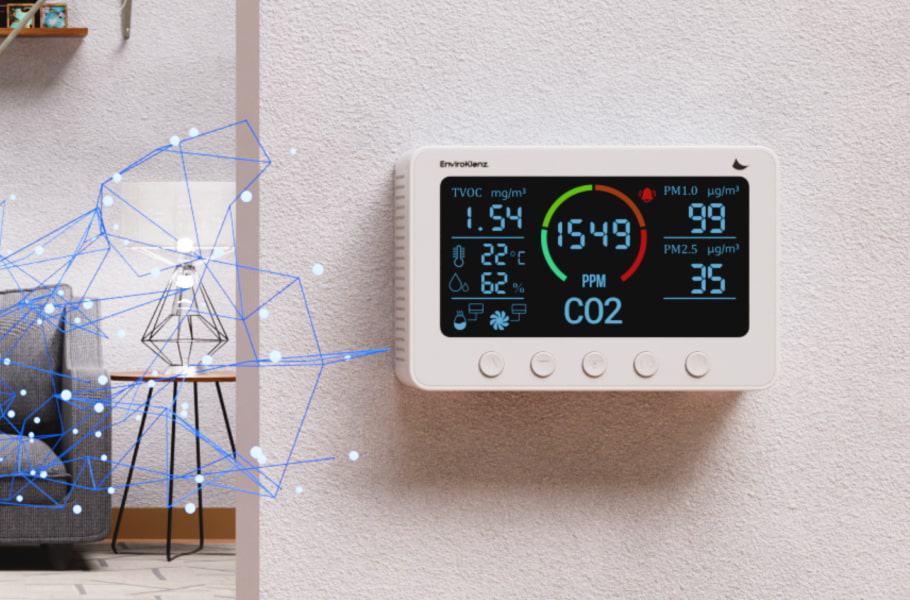Prioritizing clean air in your living spaces is super important in fostering the well-being of your family. Fortunately, unlike the challenges of controlling outdoor air quality, you can take charge of the air quality within your home.
In this guide, we’ll share effective ways to test indoor air quality, along with tips on improving the air in your living space.
But first, let’s take a quick look at the telltale signs of poor indoor air quality.
Signs of Poor Indoor Air Quality
Ensuring a healthy living space starts with spotting signs of poor indoor air quality. However, some air pollutants are quite tricky to identify using mere observation, and that’s where regular testing is crucial for early detection.
We’ll get into how to thoroughly test indoor air quality in a bit. In the meantime, here are some common signs that your indoor air quality might need attention:
Poor ventilation. If your space feels stuffy or lacks a constant flow of fresh air, it’s a sign that ventilation needs improvement. Good airflow is essential to prevent a buildup of pollutants indoors.
Health problems. Persistent issues like allergies, respiratory irritation, or unexplained fatigue could be linked to poor indoor air quality and heightened environmental exposure. Indoor air quality testing helps pinpoint the cause, enabling you to take proper actions for improvement.
Unusual odors. Persistent or strong smells could indicate the presence of airborne contaminants. While some odors are harmless, indoor air quality testing can help identify and address pollutants causing unpleasant smells.
Musty smells. Musty or moldy odors signal the potential presence of mold, which can impact health. Testing can confirm the presence of mold spores and guide you in addressing the source.
How to Test Indoor Air Quality
- Monitor Indoor Air Quality With an Air Quality Monitor
- Keep Tabs on Carbon Monoxide and Radon Levels
- Get an Air Purifier
- Hire a Professional Air Quality Testing Service
Monitor Indoor Air Quality With an Air Quality Monitor

One of the easiest ways to test air quality is by purchasing an air quality monitor to keep tabs on indoor air pollution levels.
Air quality monitors provide various measurements, but we recommend a monitor that can measure humidity, VOCs, and levels of particulate matter.
The United States Environmental Protection Agency (EPA) describes particular matter as liquid droplets or solid particles in the air, such as dust, soot, and smoke.
Air quality monitors can also read dust mites levels in the air, allowing you to stay on top of the air quality in your home.
Keep Tabs on Carbon Monoxide and Radon Levels
Radon is a tasteless, colorless, and odorless radioactive gas, making it difficult to detect with the human senses. According to the EPA, this inert gas is the leading cause of lung cancer among people who have never smoked.
Breathing radon is dangerous and increases your risk of lung cancer. Fortunately, efficient modern home designs give little room for the naturally occurring gas to leak through cracks into the house.
Like radon, carbon monoxide is a tasteless, colorless, and odorless gas produced by combustion. This means that, unlike radon, carbon monoxide sources are common in most homes and include appliances like boilers, furnaces, water heaters, wood and gas fireplaces, and clothes dryers.
While it may be difficult to completely prevent these gases from entering your home, you can stop them from reaching dangerous levels by installing a radon monitor and carbon monoxide detector. These devices notify you when potentially harmful gases in your home reach unsafe levels.
Get an Air Purifier
Knowing how to test air quality in your home is pretty useless if you can’t do anything to improve IAQ. Getting an air purifier is one of the smartest things to do once you’ve confirmed air quality issues in your home.
For those with allergies or existing health concerns like asthma, an air purifier can remove pollutants and particulate matter from your home, allowing you to breathe easier.
When choosing air purifiers, consider an electronic model that uses a HEPA filtration system to trap and remove pollutants. These models are typically more effective and leave your home with better air quality.
The EnviroKlenz Air System Plus checks all the above boxes and more! The system’s 3-stage filtration process effectively removes pathogens and toxic odors and efficiently captures pet dander, particulate matter, dust, and allergens. The unit is designed to self-clean using internal UVC germicidal bulbs.
Thanks to its portable design, you can easily move it around different rooms in your home, whether you’re looking to remove cooking odors, control allergens, or get rid of mold, dust, and dander.
Hire a Professional Air Quality Testing Service
Opting for professional testing services is a savvy move for a thorough understanding of your indoor air. Certified experts bring specialized tools and know-how to the table, delivering a detailed assessment of the air you breathe at home.
They use advanced equipment to detect a range of pollutants, ensuring a comprehensive evaluation.
Professionals often go beyond surface-level observations and pinpointing existing issues. In many cases, they’ll inspect your HVAC systems and offer insights into potential sources of air quality problems. This way, you can confidently make decisions to improve your indoor air quality.
How to Improve Indoor Air Quality
Keeping the air in your indoor space clean goes beyond mere testing; learning how to proactively improve air quality is super important for maintaining overall well-being.

Here are a few practical steps you can take to enhance indoor air quality and create an environment where every breath is refreshing.
Ventilation matters. Ensure proper ventilation by regularly opening windows and doors whenever the weather outside permits. This simple act allows fresh outdoor air to circulate and dilute indoor pollutants.
Keep indoor spaces clean. Regularly clean and dust your home to minimize the buildup of allergens, dust mites, and other particles that can compromise air quality.
Stay on top of indoor humidity. Maintain optimal humidity levels in your home (ideally between 30-50%) to discourage mold growth and reduce the spread of dust mites.
Mindfully choose household products. When shopping, opt for VOC-free or low-VOC products, including paints, cleaning supplies, and furniture. Doing this will reduce the emission of harmful chemicals into your home.
Choose air-purifying plants. Some plants can help improve indoor air. Consider picking air-cleaning plants like spider plants, snake plants, or peace lilies for your indoor space.
Conclusion
Getting a grip on indoor air quality is an important step toward creating a healthier home. Just remember, deciding to test indoor air quality isn’t a one-off deal; make it a routine, especially if you spot any sign of poor air quality.
To improve the air quality in your living space, maintain proper ventilation and use good-quality air purifiers.
This way, you proactively manage indoor air quality and ensure your family breathes easy. And with regular use of an indoor air quality monitor, you can effectively detect and correct any air quality-related issues that might arise from time to time.








